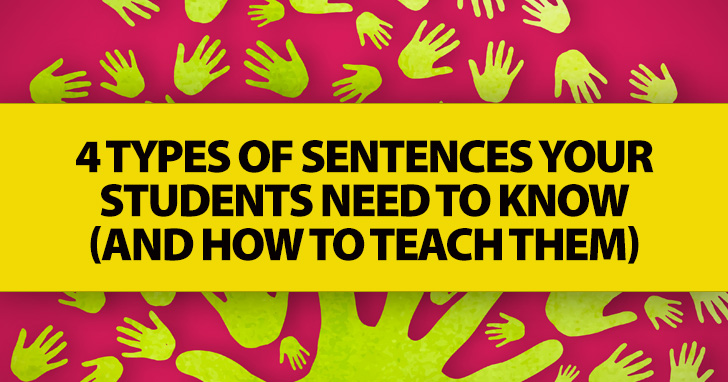4 Types of Sentences Your Students Need to Know (and How to Teach Them)


Use this simple object lesson with your class no matter what their age to teach or review sentence structure in English.
What is a Clause?
As you know, a clause is any group of words with a subject and a predicate. Clauses may be independent of other clauses achieving sentence status all on their own, or they may rely on a main clause to earn that same status. Either way, this simple object lesson will give your students a visual for sentence structure and the difference between independent and dependent clauses.
- Start by asking one student to volunteer to stand in front of the class. Tell your class that this person is a clause. He has a subject and a predicate. He is standing on his own feet, so he is free, independent. He does not need anyone else. He is an independent clause.
- Now ask another student to come in front of the class. Have this student kneel next to the first student. She is a person, and she still represents a clause. She has a subject and a predicate. However, the difference with her is she is not standing on her own feet. She needs help. She is dependent upon someone else. In this case, another clause. She is therefore a dependent clause. Stress to your students that she cannot stand alone and must be joined with an independent clause to make a grammatical sentence. Once your students understand these building blocks, reviewing the four sentence structures in English should be simple.
Simple Sentences
A simple sentence, as anyone can guess, is the most straightforward and uncomplicated of the sentence patterns in English. A simple sentence is one independent clause. The only necessary pieces are a subject and a predicate.
- Return to your first student and point out again that he is an independent clause with no other clauses attached. He is therefore a simple sentence.
A simple sentence may have a singular subject (the boy ran) a compound subject (the boy and his dog ran) or plural subject (the boys ran). It may have a direct object (the boy threw a stick) and or an indirect object (the boy threw his dog a stick). There may be adverbs, adjectives and prepositional phrases attached. It may even have a compound verb (the boy ran and played). Any of these embellishments can be paired with an independent or a dependent clause. In this case, though, as long as there is one subject and one predicate and the clause can stand on its own, it is a simple sentence.
Compound Sentences
A compound sentence is two or more independent clauses joined together usually by a coordinating conjunction. Each of the independent clauses will have its own subject and predicate. These subjects and predicates follow the same patterns given above. On their own, each of these clauses would be a simple sentence.
- At this point, you can ask the second student to return to her seat and bring another student up in front of the class. She should stand alone as did the first student. She also represents an independent clause. (For example, the first student might represent the clause, the boy played. The second standing student may represent the clause the dog ran.)
There are seven coordinating conjunctions in English. A coordinating conjunction is used to join two independent clauses into a compound sentence. At this point, you can take a large piece of paper and write the seven coordinating conjunctions on the paper. They are and, but, for, or, nor, yet and so.
- Have each of the standing students take hold of one end of the paper so that paper links them. These two students now represent a compound sentence. (The boy played, and the dog ran.) Each clause could stand independently just as each of these students can, but together with the coordinating conjunction they are a compound sentence. (The boy played, and the dog ran.) Your students should understand through this illustration that both pieces of the compound sentence are of equal importance and function. Neither is subordinate to the other just as each of the students is independent on his or her own feet. At this point, include a punctuation point and stress that students should include a comma before the coordinating conjunction in any structure of this type.
Complex Sentences
- Ask the third student to sit down and the second student (the one who was kneeling) to return to the front of the class. Explain to your students that a complex sentence contains one independent clause (the boy ran) and one or more dependent clauses (when he was at the park). There are several types of dependent clauses, but they will all have one thing in common. They are not able to stand alone without the main clause with which they are paired. At this point, you can have the kneeling student grasp one hand of the standing student. They now represent a complex sentence structure – one independent clause and one dependent clause. As for punctuation, stress the order of the clauses for your students. If the dependent clause comes at the beginning of the sentence, a comma should follow it. (When he was at the park, the boy played.) If the dependent clause comes after the independent clause, no comma is necessary. (The boy played when he was at the park.)
Compound-Complex Sentences
The final type of sentence structure in English is the compound-complex sentence. As one can guess from its name, a compound-complex sentence is the combination of each of the previous two sentence types. This means that this type of sentence will contain a two or more independent clauses joined by a coordinating conjunction (the boy played and the dog ran) as well as a dependent clause (when they were at the park).
- To illustrate this, have the third student return to the front of the class and take hold of one side of the coordinating conjunction with the first student on the other side of it. (This is the same arrangement they had earlier when explaining the compound sentence.) Then have the second student (the one kneeling representing the dependent clause) take the remaining hand of the last student to come up front. Your three students (two standing and one kneeling) now represent this compound-complex sentence structure. The boy played, and the dog ran when they were at the park. The order of the clauses does not matter in this sentence, but the punctuation will change if the dependent clause comes at the beginning of the sentence. When they were at the park, the boy played and the dog ran. Also make clear to your students that a sentence can have more than one dependent clause, but it will still be either a complex sentence or a compound-complex sentence.
Your students will remember seeing their classmates represent the different types of clauses in the different sentence structures in English. It will be a memorable object lesson and one that may make a potentially confusing subject easy to grasp, no props required.